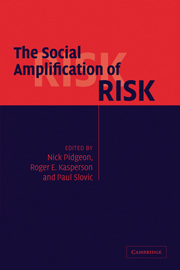Book contents
- Frontmatter
- Contents
- List of figures
- List of tables
- List of contributors
- Acknowledgments
- Introduction
- Part I Conceptual foundations
- Part II Risk signals and the mass media
- 5 Trust, transparency, and social context: implications for social amplification of risk
- 6 Risk and relativity: BSE and the British media
- 7 After amplification: rethinking the role of the media in risk communication
- 8 Plague and arsenic: assignment of blame in the mass media and the social amplification and attenuation of risk
- Part III Public perceptions and social controversy
- Part IV Risk ripples and stigma effects
- Part V Policy and management
- Bibliography
- Index
8 - Plague and arsenic: assignment of blame in the mass media and the social amplification and attenuation of risk
Published online by Cambridge University Press: 06 July 2010
- Frontmatter
- Contents
- List of figures
- List of tables
- List of contributors
- Acknowledgments
- Introduction
- Part I Conceptual foundations
- Part II Risk signals and the mass media
- 5 Trust, transparency, and social context: implications for social amplification of risk
- 6 Risk and relativity: BSE and the British media
- 7 After amplification: rethinking the role of the media in risk communication
- 8 Plague and arsenic: assignment of blame in the mass media and the social amplification and attenuation of risk
- Part III Public perceptions and social controversy
- Part IV Risk ripples and stigma effects
- Part V Policy and management
- Bibliography
- Index
Summary
Societal responses to hazard events are perplexing. In the past, people have equated these societal responses with the potential injuries and deaths resulting from the hazards. More recently, however, hazard researchers have identified additional factors, such as mass media, organizational responses, and nature of the hazard, that shape societal response to hazard events. In other words, there is no linear relationship between societal responses and the injuries and deaths that result from a hazard event.
What factor(s) coalesce with the magnitude of the event to explain societal response to hazard events? This question remains a challenge for hazard researchers. Two hazard events described below demonstrate that societal responses depart from the magnitude of the event. These events characterize human experience of risk and provide an opportunity to explain how interactions with some hazard events produce intense societal reactions, while many others remain unnoticed.
In September 1994, reports on the reappearance of the bacterium Yersinia pestis in Surat indicated recurrence of the plague in India. Word of the plague quickly spread through the mass media and social networks. Despite local authorities' assurances of safety, rumors of a large number of deaths because of the plague occurred in the Surat. Public concern about the management of the hazard was widespread.
Within hours of the first appearance of the reports on the plague, an estimated 200,000 people deserted Surat. Hundreds of people arrived at the public and private hospitals of the city seeking assurance that they were not infected.
- Type
- Chapter
- Information
- The Social Amplification of Risk , pp. 179 - 206Publisher: Cambridge University PressPrint publication year: 2003
- 9
- Cited by

